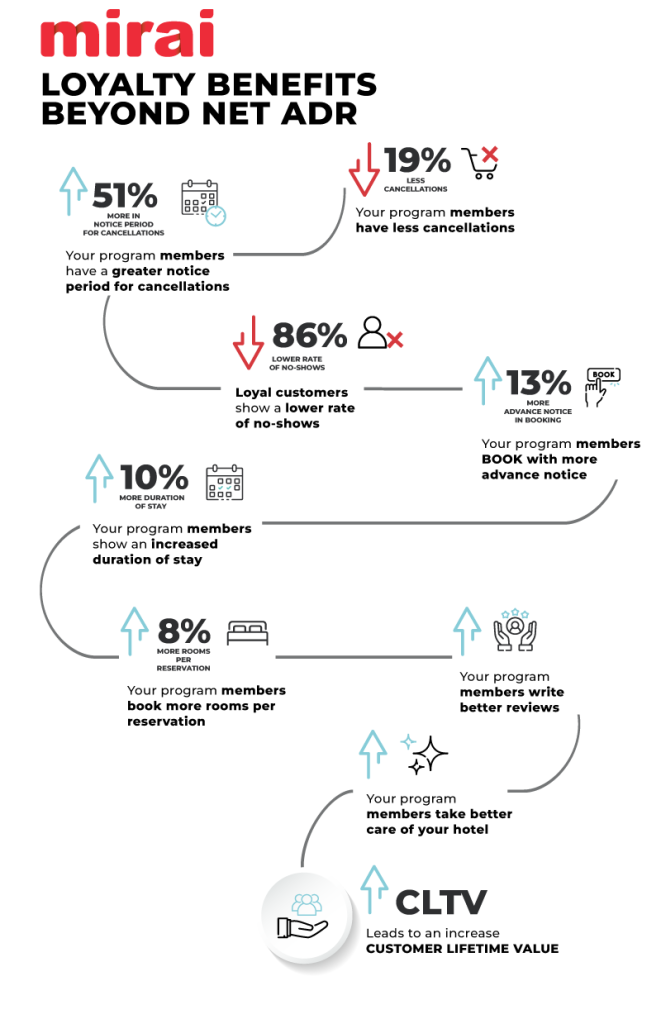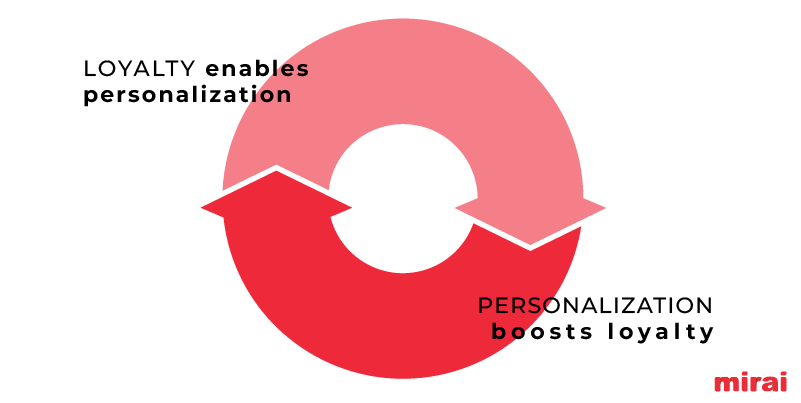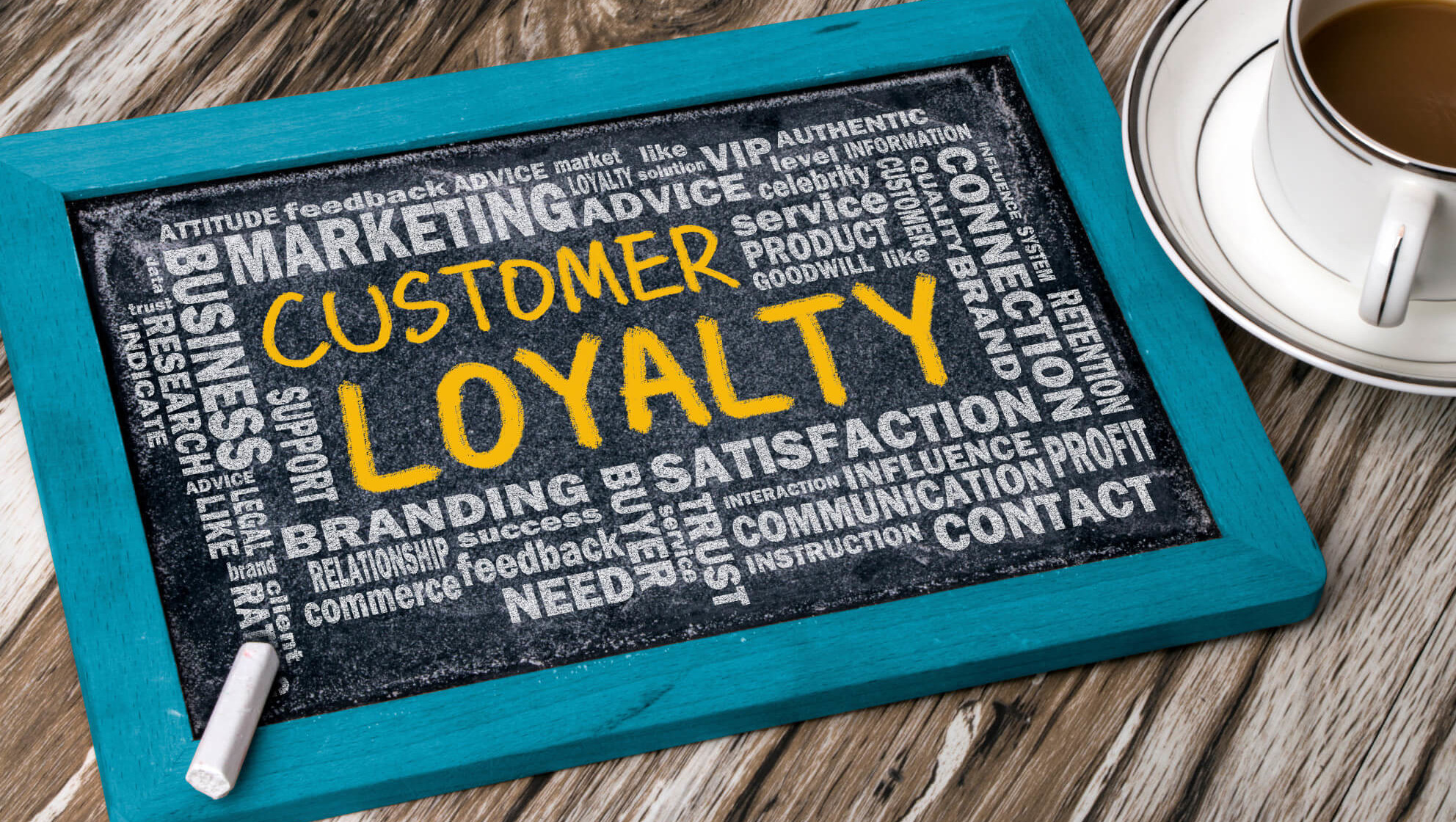Launching a loyalty program is one of the best ways to boost your direct channel while improving the profitability of your distribution.
NB: This is an article from mirai, one of our Expert Partners
Subscribe to our weekly newsletter and stay up to date
But beyond a mere net ADR analysis, loyalty adds many other advantages that positively impact your bottom line but are more difficult to trace and, therefore, many times are ignored:
- Members cancel 19% less than non-members, making your revenue management efforts more effective and your life much easier.
- Members cancel 51% more days earlier than non-members, giving you more time to sell those rooms again. For example, if non-members cancel on average 20 days prior check-in date, members do so 30 days. Additionally, having more time is key to drive those reservations through the direct channel again. The closer to the check in date, the more hotels lean on OTAs.
- Members no-show 86% less than non-members, preventing you from leaving all that money on the table. An empty room, especially in the high season, is your RevPar’s worst enemy.
- Members book 13% more days in advance, helping you to plan better and increase your rates earlier. It also helps you staff your operations in advance.
- Members stay 10% longer than non-members, consequently reducing your operational costs (cleaning the room and check-in and check-out processes).
- Members book 8% more rooms per booking than non-members, proportionally increasing your average booking value and the ROI of your marketing campaigns.
- Members write better reviews than non-members. Their high satisfaction with your hotel is what makes them repeat. They also recommend your hotel to friends and relatives, as if they worked for you as sales reps.
- Members take care of your hotel more than non-members, reducing your capex spent to keep the hotel updated.

Loyalty, your ally to increase the customer lifetime value of your clients
Organizations should adopt a customer lifetime value mindset to truly take advantage of the power of loyalty. Driving new customers will always be much more expensive than retaining existing ones. Hotels that assume their guests don’t repeat on their destinations are losing a great opportunity and putting a red carpet to the OTAs to capture them.
Customer lifetime value is not a platform but a philosophy that should be rooted in your organization’s DNA. All your guests are candidates to repeat in the future, maybe in weeks, months or years. Understanding that “on average, all your guests will repeat X times in the following Y years” will completely change the way you run your hotel distribution and marketing. Many hotels would never invest $200 to drive a customer who will spend $1,000. However, if you knew that same customer will, on average, stay in your hotel 2.5 times (totaling $2,500 in revenue) in the next five years … Would your decision be the same?
The customer lifetime value, or CLTV, is an actual number, represented in dollars, meaning the amount of money a customer will spend on your hotel/chain over time. A customer with a $10,000 CLTV is much more attractive than another with $100. New guests are challenging as hotels have no or little information about their preferences. Third party data is available to, at least, have something to start with. Nonetheless, CLTV of new guests tends to be low. However, these guests will spend days in your property, enabling you to get to know them better this time with first party data. This high value information will help you customize their future experiences while increasing their CLTV at the same time. Similarly, the more information you have about your customers, the higher the chances that they’ll repeat. Just as a flywheel that feedbacks itself endlessly.

OTAs have traditionally been out of the “onsite” customers’ experiences, losing this valuable information about their preferences. Unfortunately, very few hotels took advantage of this gold mine and now OTAs are digging in it. Haven’t you seen Booking.com and Expedia asking “your guests” about their experiences during their stay in your hotel? They are exactly working on converting your customers into theirs. It may sound like a small detail, but it’s not.
Conclusion
Loyalty increases the quality of your bookings way beyond a positive impact in net ADR and brings many advantages, both from a planning to an operational perspective, that make your life easier and less dependent on the OTAs.
Loyalty also helps you build a high-quality and first-party customer database that should be key in your long term strategy, when competing with other hotels, as well as other distribution channels (typically OTAs).
All this might sound complicated or unaffordable. It’s not the case. Adopting a long term loyalty mindset, and making the ball start rolling, is actually simple. The hardest part is, curiously, your willingness to do it. You’ll eventually need technology and knowledge, but nothing you cannot find in the market.
At the end of the day, you decide whether you make loyal customers to you or let OTAs make loyal customers to them. It’s in your hands to make the right decision.







